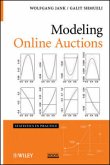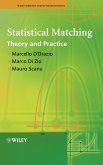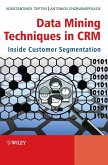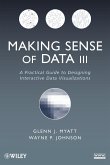Carlo Vercellis
Business Intelligence
Carlo Vercellis
Business Intelligence
- Gebundenes Buch
- Merkliste
- Auf die Merkliste
- Bewerten Bewerten
- Teilen
- Produkt teilen
- Produkterinnerung
- Produkterinnerung
Business intelligence is a broad category of applications and technologies for gathering, providing access to, and analyzing data for the purpose of helping enterprise users make better business decisions. The term implies having a comprehensive knowledge of all factors that affect a business, such as customers, competitors, business partners, economic environment, and internal operations, therefore enabling optimal decisions to be made.
Business Intelligence provides readers with an introduction and practical guide to the mathematical models and analysis methodologies vital to business…mehr
Andere Kunden interessierten sich auch für
![Business Intelligence Business Intelligence]() Carlo VercellisBusiness Intelligence94,99 €
Carlo VercellisBusiness Intelligence94,99 €![Modeling Online Auctions Modeling Online Auctions]() Wolfgang JankModeling Online Auctions143,99 €
Wolfgang JankModeling Online Auctions143,99 €![Statistical Matching Statistical Matching]() Marcello D'OrazioStatistical Matching138,99 €
Marcello D'OrazioStatistical Matching138,99 €![Data Mining Techniques in Crm Data Mining Techniques in Crm]() Konstantinos TsiptsisData Mining Techniques in Crm106,99 €
Konstantinos TsiptsisData Mining Techniques in Crm106,99 €![Decision Support Systems for Business Intelligence Decision Support Systems for Business Intelligence]() Vicki L. SauterDecision Support Systems for Business Intelligence146,99 €
Vicki L. SauterDecision Support Systems for Business Intelligence146,99 €![Making Sense of Data III Making Sense of Data III]() Glenn J MyattMaking Sense of Data III112,99 €
Glenn J MyattMaking Sense of Data III112,99 €![Leaders and Innovators Leaders and Innovators]() Tho H. NguyenLeaders and Innovators38,99 €
Tho H. NguyenLeaders and Innovators38,99 €-
-
-
Business intelligence is a broad category of applications and technologies for gathering, providing access to, and analyzing data for the purpose of helping enterprise users make better business decisions. The term implies having a comprehensive knowledge of all factors that affect a business, such as customers, competitors, business partners, economic environment, and internal operations, therefore enabling optimal decisions to be made.
Business Intelligence provides readers with an introduction and practical guide to the mathematical models and analysis methodologies vital to business intelligence.
This book:
Combines detailed coverage with a practical guide to the mathematical models and analysis methodologies of business intelligence.
Covers all the hot topics such as data warehousing, data mining and its applications, machine learning, classification, supply optimization models, decision support systems, and analytical methods for performance evaluation.
Is made accessible to readers through the careful definition and introduction of each concept, followed by the extensive use of examples and numerous real-life case studies.
Explains how to utilise mathematical models and analysis models to make effective and good quality business decisions.
This book is aimed at postgraduate students following data analysis and data mining courses.
Researchers looking for a systematic and broad coverage of topics in operations research and mathematical models for decision-making will find this an invaluable guide.
Hinweis: Dieser Artikel kann nur an eine deutsche Lieferadresse ausgeliefert werden.
Business Intelligence provides readers with an introduction and practical guide to the mathematical models and analysis methodologies vital to business intelligence.
This book:
Combines detailed coverage with a practical guide to the mathematical models and analysis methodologies of business intelligence.
Covers all the hot topics such as data warehousing, data mining and its applications, machine learning, classification, supply optimization models, decision support systems, and analytical methods for performance evaluation.
Is made accessible to readers through the careful definition and introduction of each concept, followed by the extensive use of examples and numerous real-life case studies.
Explains how to utilise mathematical models and analysis models to make effective and good quality business decisions.
This book is aimed at postgraduate students following data analysis and data mining courses.
Researchers looking for a systematic and broad coverage of topics in operations research and mathematical models for decision-making will find this an invaluable guide.
Hinweis: Dieser Artikel kann nur an eine deutsche Lieferadresse ausgeliefert werden.
Produktdetails
- Produktdetails
- Verlag: Wiley & Sons
- 1. Auflage
- Seitenzahl: 448
- Erscheinungstermin: 1. Mai 2009
- Englisch
- Abmessung: 235mm x 157mm x 28mm
- Gewicht: 756g
- ISBN-13: 9780470511381
- ISBN-10: 0470511389
- Artikelnr.: 23333306
- Herstellerkennzeichnung
- Libri GmbH
- Europaallee 1
- 36244 Bad Hersfeld
- gpsr@libri.de
- Verlag: Wiley & Sons
- 1. Auflage
- Seitenzahl: 448
- Erscheinungstermin: 1. Mai 2009
- Englisch
- Abmessung: 235mm x 157mm x 28mm
- Gewicht: 756g
- ISBN-13: 9780470511381
- ISBN-10: 0470511389
- Artikelnr.: 23333306
- Herstellerkennzeichnung
- Libri GmbH
- Europaallee 1
- 36244 Bad Hersfeld
- gpsr@libri.de
Carlo Vercellis - School of Management, Politecnico di Milano, Italy As well as teaching courses in Operations Research and Business Intelligence, Professor Vercellis is director of the research group MOLD (Mathematical Modeling, Optimization, Learning from Data). He has written four book in Italian, contributed to numerous other books, and has had many papers published in a variety of international journals.
Preface xiii
I Components of the decision-making process 1
1 Business intelligence 3
1.1 Effective and timely decisions 3
1.2 Data, information and knowledge 6
1.3 The role of mathematical models 8
1.4 Business intelligence architectures 9
1.4.1 Cycle of a business intelligence analysis 11
1.4.2 Enabling factors in business intelligence projects 13
1.4.3 Development of a business intelligence system 14
1.5 Ethics and business intelligence 17
1.6 Notes and readings 18
2 Decision support systems 21
2.1 Definition of system 21
2.2 Representation of the decision-making process 23
2.2.1 Rationality and problem solving 24
2.2.2 The decision-making process 25
2.2.3 Types of decisions 29
2.2.4 Approaches to the decision-making process 33
2.3 Evolution of information systems 35
2.4 Definition of decision support system 36
2.5 Development of a decision support system 40
2.6 Notes and readings 43
3 Data warehousing 45
3.1 Definition of data warehouse 45
3.1.1 Data marts 49
3.1.2 Data quality 50
3.2 Data warehouse architecture 51
3.2.1 ETL tools 53
3.2.2 Metadata 54
3.3 Cubes and multidimensional analysis 55
3.3.1 Hierarchies of concepts and OLAP operations 60
3.3.2 Materialization of cubes of data 61
3.4 Notes and readings 62
II Mathematical Models and Methods 63
4 Mathematical models for decision making 65
4.1 Structure of mathematical models 65
4.2 Development of a model 67
4.3 Classes of models 70
4.4 Notes and readings 75
5 Data mining 77
5.1 Definition of data mining 77
5.1.1 Models and methods for data mining 79
5.1.2 Data mining, classical statistics and OLAP 80
5.1.3 Applications of data mining 81
5.2 Representation of input data 82
5.3 Data mining process 84
5.4 Analysis methodologies 90
5.5 Notes and readings 94
6 Data preparation 95
6.1 Data validation 95
6.1.1 Incomplete data 96
6.1.2 Data affected by noise 97
6.2 Data transformation 99
6.2.1 Standardization 99
6.2.2 Feature extraction 100
6.3 Data reduction 100
6.3.1 Sampling 101
6.3.2 Feature selection 102
6.3.3 Principal component analysis 104
6.3.4 Data discretization 109
7 Data exploration 113
7.1 Univariate analysis 113
7.1.1 Graphical analysis of categorical attributes 114
7.1.2 Graphical analysis of numerical attributes 116
7.1.3 Measures of central tendency for numerical attributes 118
7.1.4 Measures of dispersion for numerical attributes 121
7.1.5 Measures of relative location for numerical attributes 126
7.1.6 Identification of outliers for numerical attributes 127
7.1.7 Measures of heterogeneity for categorical attributes 129
7.1.8 Analysis of the empirical density 130
7.1.9 Summary statistics 135
7.2 Bivariate analysis 136
7.2.1 Graphical analysis 136
7.2.2 Measures of correlation for numerical attributes 142
7.2.3 Contingency tables for categorical attributes 145
7.3 Multivariate analysis 147
7.3.1 Graphical analysis 147
7.3.2 Measures of correlation for numerical attributes 149
7.4 Notes and readings 152
8 Regression 153
8.1 Structure of regression models 153
8.2 Simple linear regression 156
8.2.1 Calculating the regression line 158
8.3 Multiple linear regression 161
8.3.1 Calculating the regression coefficients 162
8.3.2 Assumptions on the residuals 163
8.3.3 Treatment of categorical predictive attributes 166
8.3.4 Ridge regression 167
8.3.5 Generalized linear regression 168
8.4 Validation of regression models 168
8.4.1 Normality and independence of the residuals 169
8.4.2 Significance of the coefficients 172
8.4.3 Analysis of variance 174
8.4.4 Coefficient of determination 175
8.4.5 Coefficient of linear correlation 176
8.4.6 Multicollinearity of the independent variables 177
8.4.7 Confidence and prediction limits 178
8.5 Selection of predictive variables 179
8.5.1 Example of development of a regression model 180
8.6 Notes and readings 185
9 Time series 187
9.1 Definition of time series 187
9.1.1 Index numbers 190
9.2 Evaluating time series models 192
9.2.1 Distortion measures 192
9.2.2 Dispersion measures 193
9.2.3 Tracking signal 194
9.3 Analysis of the components of time series 195
9.3.1 Moving average 196
9.3.2 Decomposition of a time series 198
9.4 Exponential smoothing models 203
9.4.1 Simple exponential smoothing 203
9.4.2 Exponential smoothing with trend adjustment 204
9.4.3 Exponential smoothing with trend and seasonality 206
9.4.4 Simple adaptive exponential smoothing 207
9.4.5 Exponential smoothing with damped trend 208
9.4.6 Initial values for exponential smoothing models 209
9.4.7 Removal of trend and seasonality 209
9.5 Autoregressive models 210
9.5.1 Moving average models 212
9.5.2 Autoregressive moving average models 212
9.5.3 Autoregressive integrated moving average models 212
9.5.4 Identification of autoregressive models 213
9.6 Combination of predictive models 216
9.7 The forecasting process 217
9.7.1 Characteristics of the forecasting process 217
9.7.2 Selection of a forecasting method 219
9.8 Notes and readings 219
10 Classification 221
10.1 Classification problems 221
10.1.1 Taxonomy of classification models 224
10.2 Evaluation of classification models 226
10.2.1 Holdout method 228
10.2.2 Repeated random sampling 228
10.2.3 Cross-validation 229
10.2.4 Confusion matrices 230
10.2.5 ROC curve charts 233
10.2.6 Cumulative gain and lift charts 234
10.3 Classification trees 236
10.3.1 Splitting rules 240
10.3.2 Univariate splitting criteria 243
10.3.3 Example of development of a classification tree 246
10.3.4 Stopping criteria and pruning rules 250
10.4 Bayesian methods 251
10.4.1 Naive Bayesian classifiers 252
10.4.2 Example of naive Bayes classifier 253
10.4.3 Bayesian networks 256
10.5 Logistic regression 257
10.6 Neural networks 259
10.6.1 The Rosenblatt perceptron 259
10.6.2 Multi-level feed-forward networks 260
10.7 Support vector machines 262
10.7.1 Structural risk minimization 262
10.7.2 Maximal margin hyperplane for linear separation 266
10.7.3 Nonlinear separation 270
10.8 Notes and readings 275
11 Association rules 277
11.1 Motivation and structure of association rules 277
11.2 Single-dimension association rules 281
11.3 Apriori algorithm 284
11.3.1 Generation of frequent itemsets 284
11.3.2 Generation of strong rules 285
11.4 General association rules 288
11.5 Notes and readings 290
12 Clustering 293
12.1 Clustering methods 293
12.1.1 Taxonomy of clustering methods 294
12.1.2 Affinity measures 296
12.2 Partition methods 302
12.2.1 K-means algorithm 302
12.2.2 K-medoids algorithm 305
12.3 Hierarchical methods 307
12.3.1 Agglomerative hierarchical methods 308
12.3.2 Divisive hierarchical methods 310
12.4 Evaluation of clustering models 312
12.5 Notes and readings 315
III Business Intelligence Applications 317
13 Marketing models 319
13.1 Relational marketing 320
13.1.1 Motivations and objectives 320
13.1.2 An environment for relational marketing analysis 327
13.1.3 Lifetime value 329
13.1.4 The effect of latency in predictive models 332
13.1.5 Acquisition 333
13.1.6 Retention 334
13.1.7 Cross-selling and up-selling 335
13.1.8 Market basket analysis 335
13.1.9 Web mining 336
13.2 Salesforce management 338
13.2.1 Decision processes in salesforce management 339
13.2.2 Models for salesforce management 342
13.2.3 Response functions 343
13.2.4 Sales territory design 346
13.2.5 Calls and product presentations planning 347
13.3 Business case studies 352
13.3.1 Retention in telecommunications 352
13.3.2 Acquisition in the automotive industry 354
13.3.3 Cross-selling in the retail industry 358
13.4 Notes and readings 360
14 Logistic and production models 361
14.1 Supply chain optimization 362
14.2 Optimization models for logistics planning 364
14.2.1 Tactical planning 364
14.2.2 Extra capacity 365
14.2.3 Multiple resources 366
14.2.4 Backlogging 366
14.2.5 Minimum lots and fixed costs 369
14.2.6 Bill of materials 370
14.2.7 Multiple plants 371
14.3 Revenue management systems 372
14.3.1 Decision processes in revenue management 373
14.4 Business case studies 376
14.4.1 Logistics planning in the food industry 376
14.4.2 Logistics planning in the packaging industry 383
14.5 Notes and readings 384
15 Data envelopment analysis 385
15.1 Efficiency measures 386
15.2 Efficient frontier 386
15.3 The CCR model 390
15.3.1 Definition of target objectives 392
15.3.2 Peer groups 393
15.4 Identification of good operating practices 394
15.4.1 Cross-efficiency analysis 394
15.4.2 Virtual inputs and virtual outputs 395
15.4.3 Weight restrictions 396
15.5 Other models 396
15.6 Notes and readings 397
Appendix A Software tools 399
Appendix B Dataset repositories 401
References 403
Index 413
I Components of the decision-making process 1
1 Business intelligence 3
1.1 Effective and timely decisions 3
1.2 Data, information and knowledge 6
1.3 The role of mathematical models 8
1.4 Business intelligence architectures 9
1.4.1 Cycle of a business intelligence analysis 11
1.4.2 Enabling factors in business intelligence projects 13
1.4.3 Development of a business intelligence system 14
1.5 Ethics and business intelligence 17
1.6 Notes and readings 18
2 Decision support systems 21
2.1 Definition of system 21
2.2 Representation of the decision-making process 23
2.2.1 Rationality and problem solving 24
2.2.2 The decision-making process 25
2.2.3 Types of decisions 29
2.2.4 Approaches to the decision-making process 33
2.3 Evolution of information systems 35
2.4 Definition of decision support system 36
2.5 Development of a decision support system 40
2.6 Notes and readings 43
3 Data warehousing 45
3.1 Definition of data warehouse 45
3.1.1 Data marts 49
3.1.2 Data quality 50
3.2 Data warehouse architecture 51
3.2.1 ETL tools 53
3.2.2 Metadata 54
3.3 Cubes and multidimensional analysis 55
3.3.1 Hierarchies of concepts and OLAP operations 60
3.3.2 Materialization of cubes of data 61
3.4 Notes and readings 62
II Mathematical Models and Methods 63
4 Mathematical models for decision making 65
4.1 Structure of mathematical models 65
4.2 Development of a model 67
4.3 Classes of models 70
4.4 Notes and readings 75
5 Data mining 77
5.1 Definition of data mining 77
5.1.1 Models and methods for data mining 79
5.1.2 Data mining, classical statistics and OLAP 80
5.1.3 Applications of data mining 81
5.2 Representation of input data 82
5.3 Data mining process 84
5.4 Analysis methodologies 90
5.5 Notes and readings 94
6 Data preparation 95
6.1 Data validation 95
6.1.1 Incomplete data 96
6.1.2 Data affected by noise 97
6.2 Data transformation 99
6.2.1 Standardization 99
6.2.2 Feature extraction 100
6.3 Data reduction 100
6.3.1 Sampling 101
6.3.2 Feature selection 102
6.3.3 Principal component analysis 104
6.3.4 Data discretization 109
7 Data exploration 113
7.1 Univariate analysis 113
7.1.1 Graphical analysis of categorical attributes 114
7.1.2 Graphical analysis of numerical attributes 116
7.1.3 Measures of central tendency for numerical attributes 118
7.1.4 Measures of dispersion for numerical attributes 121
7.1.5 Measures of relative location for numerical attributes 126
7.1.6 Identification of outliers for numerical attributes 127
7.1.7 Measures of heterogeneity for categorical attributes 129
7.1.8 Analysis of the empirical density 130
7.1.9 Summary statistics 135
7.2 Bivariate analysis 136
7.2.1 Graphical analysis 136
7.2.2 Measures of correlation for numerical attributes 142
7.2.3 Contingency tables for categorical attributes 145
7.3 Multivariate analysis 147
7.3.1 Graphical analysis 147
7.3.2 Measures of correlation for numerical attributes 149
7.4 Notes and readings 152
8 Regression 153
8.1 Structure of regression models 153
8.2 Simple linear regression 156
8.2.1 Calculating the regression line 158
8.3 Multiple linear regression 161
8.3.1 Calculating the regression coefficients 162
8.3.2 Assumptions on the residuals 163
8.3.3 Treatment of categorical predictive attributes 166
8.3.4 Ridge regression 167
8.3.5 Generalized linear regression 168
8.4 Validation of regression models 168
8.4.1 Normality and independence of the residuals 169
8.4.2 Significance of the coefficients 172
8.4.3 Analysis of variance 174
8.4.4 Coefficient of determination 175
8.4.5 Coefficient of linear correlation 176
8.4.6 Multicollinearity of the independent variables 177
8.4.7 Confidence and prediction limits 178
8.5 Selection of predictive variables 179
8.5.1 Example of development of a regression model 180
8.6 Notes and readings 185
9 Time series 187
9.1 Definition of time series 187
9.1.1 Index numbers 190
9.2 Evaluating time series models 192
9.2.1 Distortion measures 192
9.2.2 Dispersion measures 193
9.2.3 Tracking signal 194
9.3 Analysis of the components of time series 195
9.3.1 Moving average 196
9.3.2 Decomposition of a time series 198
9.4 Exponential smoothing models 203
9.4.1 Simple exponential smoothing 203
9.4.2 Exponential smoothing with trend adjustment 204
9.4.3 Exponential smoothing with trend and seasonality 206
9.4.4 Simple adaptive exponential smoothing 207
9.4.5 Exponential smoothing with damped trend 208
9.4.6 Initial values for exponential smoothing models 209
9.4.7 Removal of trend and seasonality 209
9.5 Autoregressive models 210
9.5.1 Moving average models 212
9.5.2 Autoregressive moving average models 212
9.5.3 Autoregressive integrated moving average models 212
9.5.4 Identification of autoregressive models 213
9.6 Combination of predictive models 216
9.7 The forecasting process 217
9.7.1 Characteristics of the forecasting process 217
9.7.2 Selection of a forecasting method 219
9.8 Notes and readings 219
10 Classification 221
10.1 Classification problems 221
10.1.1 Taxonomy of classification models 224
10.2 Evaluation of classification models 226
10.2.1 Holdout method 228
10.2.2 Repeated random sampling 228
10.2.3 Cross-validation 229
10.2.4 Confusion matrices 230
10.2.5 ROC curve charts 233
10.2.6 Cumulative gain and lift charts 234
10.3 Classification trees 236
10.3.1 Splitting rules 240
10.3.2 Univariate splitting criteria 243
10.3.3 Example of development of a classification tree 246
10.3.4 Stopping criteria and pruning rules 250
10.4 Bayesian methods 251
10.4.1 Naive Bayesian classifiers 252
10.4.2 Example of naive Bayes classifier 253
10.4.3 Bayesian networks 256
10.5 Logistic regression 257
10.6 Neural networks 259
10.6.1 The Rosenblatt perceptron 259
10.6.2 Multi-level feed-forward networks 260
10.7 Support vector machines 262
10.7.1 Structural risk minimization 262
10.7.2 Maximal margin hyperplane for linear separation 266
10.7.3 Nonlinear separation 270
10.8 Notes and readings 275
11 Association rules 277
11.1 Motivation and structure of association rules 277
11.2 Single-dimension association rules 281
11.3 Apriori algorithm 284
11.3.1 Generation of frequent itemsets 284
11.3.2 Generation of strong rules 285
11.4 General association rules 288
11.5 Notes and readings 290
12 Clustering 293
12.1 Clustering methods 293
12.1.1 Taxonomy of clustering methods 294
12.1.2 Affinity measures 296
12.2 Partition methods 302
12.2.1 K-means algorithm 302
12.2.2 K-medoids algorithm 305
12.3 Hierarchical methods 307
12.3.1 Agglomerative hierarchical methods 308
12.3.2 Divisive hierarchical methods 310
12.4 Evaluation of clustering models 312
12.5 Notes and readings 315
III Business Intelligence Applications 317
13 Marketing models 319
13.1 Relational marketing 320
13.1.1 Motivations and objectives 320
13.1.2 An environment for relational marketing analysis 327
13.1.3 Lifetime value 329
13.1.4 The effect of latency in predictive models 332
13.1.5 Acquisition 333
13.1.6 Retention 334
13.1.7 Cross-selling and up-selling 335
13.1.8 Market basket analysis 335
13.1.9 Web mining 336
13.2 Salesforce management 338
13.2.1 Decision processes in salesforce management 339
13.2.2 Models for salesforce management 342
13.2.3 Response functions 343
13.2.4 Sales territory design 346
13.2.5 Calls and product presentations planning 347
13.3 Business case studies 352
13.3.1 Retention in telecommunications 352
13.3.2 Acquisition in the automotive industry 354
13.3.3 Cross-selling in the retail industry 358
13.4 Notes and readings 360
14 Logistic and production models 361
14.1 Supply chain optimization 362
14.2 Optimization models for logistics planning 364
14.2.1 Tactical planning 364
14.2.2 Extra capacity 365
14.2.3 Multiple resources 366
14.2.4 Backlogging 366
14.2.5 Minimum lots and fixed costs 369
14.2.6 Bill of materials 370
14.2.7 Multiple plants 371
14.3 Revenue management systems 372
14.3.1 Decision processes in revenue management 373
14.4 Business case studies 376
14.4.1 Logistics planning in the food industry 376
14.4.2 Logistics planning in the packaging industry 383
14.5 Notes and readings 384
15 Data envelopment analysis 385
15.1 Efficiency measures 386
15.2 Efficient frontier 386
15.3 The CCR model 390
15.3.1 Definition of target objectives 392
15.3.2 Peer groups 393
15.4 Identification of good operating practices 394
15.4.1 Cross-efficiency analysis 394
15.4.2 Virtual inputs and virtual outputs 395
15.4.3 Weight restrictions 396
15.5 Other models 396
15.6 Notes and readings 397
Appendix A Software tools 399
Appendix B Dataset repositories 401
References 403
Index 413
Preface xiii
I Components of the decision-making process 1
1 Business intelligence 3
1.1 Effective and timely decisions 3
1.2 Data, information and knowledge 6
1.3 The role of mathematical models 8
1.4 Business intelligence architectures 9
1.4.1 Cycle of a business intelligence analysis 11
1.4.2 Enabling factors in business intelligence projects 13
1.4.3 Development of a business intelligence system 14
1.5 Ethics and business intelligence 17
1.6 Notes and readings 18
2 Decision support systems 21
2.1 Definition of system 21
2.2 Representation of the decision-making process 23
2.2.1 Rationality and problem solving 24
2.2.2 The decision-making process 25
2.2.3 Types of decisions 29
2.2.4 Approaches to the decision-making process 33
2.3 Evolution of information systems 35
2.4 Definition of decision support system 36
2.5 Development of a decision support system 40
2.6 Notes and readings 43
3 Data warehousing 45
3.1 Definition of data warehouse 45
3.1.1 Data marts 49
3.1.2 Data quality 50
3.2 Data warehouse architecture 51
3.2.1 ETL tools 53
3.2.2 Metadata 54
3.3 Cubes and multidimensional analysis 55
3.3.1 Hierarchies of concepts and OLAP operations 60
3.3.2 Materialization of cubes of data 61
3.4 Notes and readings 62
II Mathematical Models and Methods 63
4 Mathematical models for decision making 65
4.1 Structure of mathematical models 65
4.2 Development of a model 67
4.3 Classes of models 70
4.4 Notes and readings 75
5 Data mining 77
5.1 Definition of data mining 77
5.1.1 Models and methods for data mining 79
5.1.2 Data mining, classical statistics and OLAP 80
5.1.3 Applications of data mining 81
5.2 Representation of input data 82
5.3 Data mining process 84
5.4 Analysis methodologies 90
5.5 Notes and readings 94
6 Data preparation 95
6.1 Data validation 95
6.1.1 Incomplete data 96
6.1.2 Data affected by noise 97
6.2 Data transformation 99
6.2.1 Standardization 99
6.2.2 Feature extraction 100
6.3 Data reduction 100
6.3.1 Sampling 101
6.3.2 Feature selection 102
6.3.3 Principal component analysis 104
6.3.4 Data discretization 109
7 Data exploration 113
7.1 Univariate analysis 113
7.1.1 Graphical analysis of categorical attributes 114
7.1.2 Graphical analysis of numerical attributes 116
7.1.3 Measures of central tendency for numerical attributes 118
7.1.4 Measures of dispersion for numerical attributes 121
7.1.5 Measures of relative location for numerical attributes 126
7.1.6 Identification of outliers for numerical attributes 127
7.1.7 Measures of heterogeneity for categorical attributes 129
7.1.8 Analysis of the empirical density 130
7.1.9 Summary statistics 135
7.2 Bivariate analysis 136
7.2.1 Graphical analysis 136
7.2.2 Measures of correlation for numerical attributes 142
7.2.3 Contingency tables for categorical attributes 145
7.3 Multivariate analysis 147
7.3.1 Graphical analysis 147
7.3.2 Measures of correlation for numerical attributes 149
7.4 Notes and readings 152
8 Regression 153
8.1 Structure of regression models 153
8.2 Simple linear regression 156
8.2.1 Calculating the regression line 158
8.3 Multiple linear regression 161
8.3.1 Calculating the regression coefficients 162
8.3.2 Assumptions on the residuals 163
8.3.3 Treatment of categorical predictive attributes 166
8.3.4 Ridge regression 167
8.3.5 Generalized linear regression 168
8.4 Validation of regression models 168
8.4.1 Normality and independence of the residuals 169
8.4.2 Significance of the coefficients 172
8.4.3 Analysis of variance 174
8.4.4 Coefficient of determination 175
8.4.5 Coefficient of linear correlation 176
8.4.6 Multicollinearity of the independent variables 177
8.4.7 Confidence and prediction limits 178
8.5 Selection of predictive variables 179
8.5.1 Example of development of a regression model 180
8.6 Notes and readings 185
9 Time series 187
9.1 Definition of time series 187
9.1.1 Index numbers 190
9.2 Evaluating time series models 192
9.2.1 Distortion measures 192
9.2.2 Dispersion measures 193
9.2.3 Tracking signal 194
9.3 Analysis of the components of time series 195
9.3.1 Moving average 196
9.3.2 Decomposition of a time series 198
9.4 Exponential smoothing models 203
9.4.1 Simple exponential smoothing 203
9.4.2 Exponential smoothing with trend adjustment 204
9.4.3 Exponential smoothing with trend and seasonality 206
9.4.4 Simple adaptive exponential smoothing 207
9.4.5 Exponential smoothing with damped trend 208
9.4.6 Initial values for exponential smoothing models 209
9.4.7 Removal of trend and seasonality 209
9.5 Autoregressive models 210
9.5.1 Moving average models 212
9.5.2 Autoregressive moving average models 212
9.5.3 Autoregressive integrated moving average models 212
9.5.4 Identification of autoregressive models 213
9.6 Combination of predictive models 216
9.7 The forecasting process 217
9.7.1 Characteristics of the forecasting process 217
9.7.2 Selection of a forecasting method 219
9.8 Notes and readings 219
10 Classification 221
10.1 Classification problems 221
10.1.1 Taxonomy of classification models 224
10.2 Evaluation of classification models 226
10.2.1 Holdout method 228
10.2.2 Repeated random sampling 228
10.2.3 Cross-validation 229
10.2.4 Confusion matrices 230
10.2.5 ROC curve charts 233
10.2.6 Cumulative gain and lift charts 234
10.3 Classification trees 236
10.3.1 Splitting rules 240
10.3.2 Univariate splitting criteria 243
10.3.3 Example of development of a classification tree 246
10.3.4 Stopping criteria and pruning rules 250
10.4 Bayesian methods 251
10.4.1 Naive Bayesian classifiers 252
10.4.2 Example of naive Bayes classifier 253
10.4.3 Bayesian networks 256
10.5 Logistic regression 257
10.6 Neural networks 259
10.6.1 The Rosenblatt perceptron 259
10.6.2 Multi-level feed-forward networks 260
10.7 Support vector machines 262
10.7.1 Structural risk minimization 262
10.7.2 Maximal margin hyperplane for linear separation 266
10.7.3 Nonlinear separation 270
10.8 Notes and readings 275
11 Association rules 277
11.1 Motivation and structure of association rules 277
11.2 Single-dimension association rules 281
11.3 Apriori algorithm 284
11.3.1 Generation of frequent itemsets 284
11.3.2 Generation of strong rules 285
11.4 General association rules 288
11.5 Notes and readings 290
12 Clustering 293
12.1 Clustering methods 293
12.1.1 Taxonomy of clustering methods 294
12.1.2 Affinity measures 296
12.2 Partition methods 302
12.2.1 K-means algorithm 302
12.2.2 K-medoids algorithm 305
12.3 Hierarchical methods 307
12.3.1 Agglomerative hierarchical methods 308
12.3.2 Divisive hierarchical methods 310
12.4 Evaluation of clustering models 312
12.5 Notes and readings 315
III Business Intelligence Applications 317
13 Marketing models 319
13.1 Relational marketing 320
13.1.1 Motivations and objectives 320
13.1.2 An environment for relational marketing analysis 327
13.1.3 Lifetime value 329
13.1.4 The effect of latency in predictive models 332
13.1.5 Acquisition 333
13.1.6 Retention 334
13.1.7 Cross-selling and up-selling 335
13.1.8 Market basket analysis 335
13.1.9 Web mining 336
13.2 Salesforce management 338
13.2.1 Decision processes in salesforce management 339
13.2.2 Models for salesforce management 342
13.2.3 Response functions 343
13.2.4 Sales territory design 346
13.2.5 Calls and product presentations planning 347
13.3 Business case studies 352
13.3.1 Retention in telecommunications 352
13.3.2 Acquisition in the automotive industry 354
13.3.3 Cross-selling in the retail industry 358
13.4 Notes and readings 360
14 Logistic and production models 361
14.1 Supply chain optimization 362
14.2 Optimization models for logistics planning 364
14.2.1 Tactical planning 364
14.2.2 Extra capacity 365
14.2.3 Multiple resources 366
14.2.4 Backlogging 366
14.2.5 Minimum lots and fixed costs 369
14.2.6 Bill of materials 370
14.2.7 Multiple plants 371
14.3 Revenue management systems 372
14.3.1 Decision processes in revenue management 373
14.4 Business case studies 376
14.4.1 Logistics planning in the food industry 376
14.4.2 Logistics planning in the packaging industry 383
14.5 Notes and readings 384
15 Data envelopment analysis 385
15.1 Efficiency measures 386
15.2 Efficient frontier 386
15.3 The CCR model 390
15.3.1 Definition of target objectives 392
15.3.2 Peer groups 393
15.4 Identification of good operating practices 394
15.4.1 Cross-efficiency analysis 394
15.4.2 Virtual inputs and virtual outputs 395
15.4.3 Weight restrictions 396
15.5 Other models 396
15.6 Notes and readings 397
Appendix A Software tools 399
Appendix B Dataset repositories 401
References 403
Index 413
I Components of the decision-making process 1
1 Business intelligence 3
1.1 Effective and timely decisions 3
1.2 Data, information and knowledge 6
1.3 The role of mathematical models 8
1.4 Business intelligence architectures 9
1.4.1 Cycle of a business intelligence analysis 11
1.4.2 Enabling factors in business intelligence projects 13
1.4.3 Development of a business intelligence system 14
1.5 Ethics and business intelligence 17
1.6 Notes and readings 18
2 Decision support systems 21
2.1 Definition of system 21
2.2 Representation of the decision-making process 23
2.2.1 Rationality and problem solving 24
2.2.2 The decision-making process 25
2.2.3 Types of decisions 29
2.2.4 Approaches to the decision-making process 33
2.3 Evolution of information systems 35
2.4 Definition of decision support system 36
2.5 Development of a decision support system 40
2.6 Notes and readings 43
3 Data warehousing 45
3.1 Definition of data warehouse 45
3.1.1 Data marts 49
3.1.2 Data quality 50
3.2 Data warehouse architecture 51
3.2.1 ETL tools 53
3.2.2 Metadata 54
3.3 Cubes and multidimensional analysis 55
3.3.1 Hierarchies of concepts and OLAP operations 60
3.3.2 Materialization of cubes of data 61
3.4 Notes and readings 62
II Mathematical Models and Methods 63
4 Mathematical models for decision making 65
4.1 Structure of mathematical models 65
4.2 Development of a model 67
4.3 Classes of models 70
4.4 Notes and readings 75
5 Data mining 77
5.1 Definition of data mining 77
5.1.1 Models and methods for data mining 79
5.1.2 Data mining, classical statistics and OLAP 80
5.1.3 Applications of data mining 81
5.2 Representation of input data 82
5.3 Data mining process 84
5.4 Analysis methodologies 90
5.5 Notes and readings 94
6 Data preparation 95
6.1 Data validation 95
6.1.1 Incomplete data 96
6.1.2 Data affected by noise 97
6.2 Data transformation 99
6.2.1 Standardization 99
6.2.2 Feature extraction 100
6.3 Data reduction 100
6.3.1 Sampling 101
6.3.2 Feature selection 102
6.3.3 Principal component analysis 104
6.3.4 Data discretization 109
7 Data exploration 113
7.1 Univariate analysis 113
7.1.1 Graphical analysis of categorical attributes 114
7.1.2 Graphical analysis of numerical attributes 116
7.1.3 Measures of central tendency for numerical attributes 118
7.1.4 Measures of dispersion for numerical attributes 121
7.1.5 Measures of relative location for numerical attributes 126
7.1.6 Identification of outliers for numerical attributes 127
7.1.7 Measures of heterogeneity for categorical attributes 129
7.1.8 Analysis of the empirical density 130
7.1.9 Summary statistics 135
7.2 Bivariate analysis 136
7.2.1 Graphical analysis 136
7.2.2 Measures of correlation for numerical attributes 142
7.2.3 Contingency tables for categorical attributes 145
7.3 Multivariate analysis 147
7.3.1 Graphical analysis 147
7.3.2 Measures of correlation for numerical attributes 149
7.4 Notes and readings 152
8 Regression 153
8.1 Structure of regression models 153
8.2 Simple linear regression 156
8.2.1 Calculating the regression line 158
8.3 Multiple linear regression 161
8.3.1 Calculating the regression coefficients 162
8.3.2 Assumptions on the residuals 163
8.3.3 Treatment of categorical predictive attributes 166
8.3.4 Ridge regression 167
8.3.5 Generalized linear regression 168
8.4 Validation of regression models 168
8.4.1 Normality and independence of the residuals 169
8.4.2 Significance of the coefficients 172
8.4.3 Analysis of variance 174
8.4.4 Coefficient of determination 175
8.4.5 Coefficient of linear correlation 176
8.4.6 Multicollinearity of the independent variables 177
8.4.7 Confidence and prediction limits 178
8.5 Selection of predictive variables 179
8.5.1 Example of development of a regression model 180
8.6 Notes and readings 185
9 Time series 187
9.1 Definition of time series 187
9.1.1 Index numbers 190
9.2 Evaluating time series models 192
9.2.1 Distortion measures 192
9.2.2 Dispersion measures 193
9.2.3 Tracking signal 194
9.3 Analysis of the components of time series 195
9.3.1 Moving average 196
9.3.2 Decomposition of a time series 198
9.4 Exponential smoothing models 203
9.4.1 Simple exponential smoothing 203
9.4.2 Exponential smoothing with trend adjustment 204
9.4.3 Exponential smoothing with trend and seasonality 206
9.4.4 Simple adaptive exponential smoothing 207
9.4.5 Exponential smoothing with damped trend 208
9.4.6 Initial values for exponential smoothing models 209
9.4.7 Removal of trend and seasonality 209
9.5 Autoregressive models 210
9.5.1 Moving average models 212
9.5.2 Autoregressive moving average models 212
9.5.3 Autoregressive integrated moving average models 212
9.5.4 Identification of autoregressive models 213
9.6 Combination of predictive models 216
9.7 The forecasting process 217
9.7.1 Characteristics of the forecasting process 217
9.7.2 Selection of a forecasting method 219
9.8 Notes and readings 219
10 Classification 221
10.1 Classification problems 221
10.1.1 Taxonomy of classification models 224
10.2 Evaluation of classification models 226
10.2.1 Holdout method 228
10.2.2 Repeated random sampling 228
10.2.3 Cross-validation 229
10.2.4 Confusion matrices 230
10.2.5 ROC curve charts 233
10.2.6 Cumulative gain and lift charts 234
10.3 Classification trees 236
10.3.1 Splitting rules 240
10.3.2 Univariate splitting criteria 243
10.3.3 Example of development of a classification tree 246
10.3.4 Stopping criteria and pruning rules 250
10.4 Bayesian methods 251
10.4.1 Naive Bayesian classifiers 252
10.4.2 Example of naive Bayes classifier 253
10.4.3 Bayesian networks 256
10.5 Logistic regression 257
10.6 Neural networks 259
10.6.1 The Rosenblatt perceptron 259
10.6.2 Multi-level feed-forward networks 260
10.7 Support vector machines 262
10.7.1 Structural risk minimization 262
10.7.2 Maximal margin hyperplane for linear separation 266
10.7.3 Nonlinear separation 270
10.8 Notes and readings 275
11 Association rules 277
11.1 Motivation and structure of association rules 277
11.2 Single-dimension association rules 281
11.3 Apriori algorithm 284
11.3.1 Generation of frequent itemsets 284
11.3.2 Generation of strong rules 285
11.4 General association rules 288
11.5 Notes and readings 290
12 Clustering 293
12.1 Clustering methods 293
12.1.1 Taxonomy of clustering methods 294
12.1.2 Affinity measures 296
12.2 Partition methods 302
12.2.1 K-means algorithm 302
12.2.2 K-medoids algorithm 305
12.3 Hierarchical methods 307
12.3.1 Agglomerative hierarchical methods 308
12.3.2 Divisive hierarchical methods 310
12.4 Evaluation of clustering models 312
12.5 Notes and readings 315
III Business Intelligence Applications 317
13 Marketing models 319
13.1 Relational marketing 320
13.1.1 Motivations and objectives 320
13.1.2 An environment for relational marketing analysis 327
13.1.3 Lifetime value 329
13.1.4 The effect of latency in predictive models 332
13.1.5 Acquisition 333
13.1.6 Retention 334
13.1.7 Cross-selling and up-selling 335
13.1.8 Market basket analysis 335
13.1.9 Web mining 336
13.2 Salesforce management 338
13.2.1 Decision processes in salesforce management 339
13.2.2 Models for salesforce management 342
13.2.3 Response functions 343
13.2.4 Sales territory design 346
13.2.5 Calls and product presentations planning 347
13.3 Business case studies 352
13.3.1 Retention in telecommunications 352
13.3.2 Acquisition in the automotive industry 354
13.3.3 Cross-selling in the retail industry 358
13.4 Notes and readings 360
14 Logistic and production models 361
14.1 Supply chain optimization 362
14.2 Optimization models for logistics planning 364
14.2.1 Tactical planning 364
14.2.2 Extra capacity 365
14.2.3 Multiple resources 366
14.2.4 Backlogging 366
14.2.5 Minimum lots and fixed costs 369
14.2.6 Bill of materials 370
14.2.7 Multiple plants 371
14.3 Revenue management systems 372
14.3.1 Decision processes in revenue management 373
14.4 Business case studies 376
14.4.1 Logistics planning in the food industry 376
14.4.2 Logistics planning in the packaging industry 383
14.5 Notes and readings 384
15 Data envelopment analysis 385
15.1 Efficiency measures 386
15.2 Efficient frontier 386
15.3 The CCR model 390
15.3.1 Definition of target objectives 392
15.3.2 Peer groups 393
15.4 Identification of good operating practices 394
15.4.1 Cross-efficiency analysis 394
15.4.2 Virtual inputs and virtual outputs 395
15.4.3 Weight restrictions 396
15.5 Other models 396
15.6 Notes and readings 397
Appendix A Software tools 399
Appendix B Dataset repositories 401
References 403
Index 413








